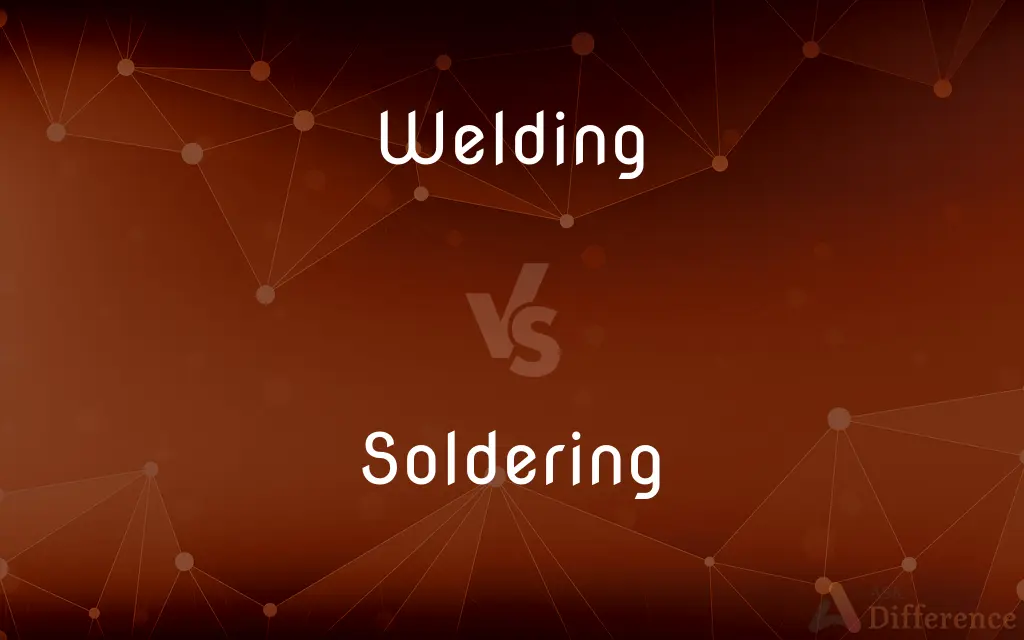Welding vs. Soldering — What's the Difference?
By Tayyaba Rehman & Fiza Rafique — Updated on May 15, 2024
Welding involves fusing materials at high temperatures, typically metals, using a filler material; soldering joins parts at lower temperatures using a metal alloy as a filler.

Difference Between Welding and Soldering
Table of Contents
ADVERTISEMENT
Key Differences
Welding is a fabrication process that joins materials, usually metals or thermoplastics, by causing coalescence. This is generally achieved by melting the workpieces and adding a filler material to form a pool of molten material that cools to become a strong joint. Soldering, on the other hand, involves joining smaller items like electronic components with a metal alloy, known as solder, which melts at a lower temperature than the work pieces.
Welding requires the base materials to be partially melted for the bond to form, which typically occurs at temperatures above 600 degrees Celsius. This high temperature ensures a strong, durable joint suitable for structural projects. Soldering uses lower temperatures typically below 450 degrees Celsius which preserves the integrity of the components and is ideal for delicate tasks such as circuit board assembly.
The equipment for welding can be complex and costly, involving protective gear, high-energy sources, and various welding tools. Soldering equipment, in contrast, is less intense and more accessible, generally comprising a soldering iron and solder wire, making it suitable for hobbyists and professionals alike.
Welding techniques vary widely, including arc welding, MIG welding, TIG welding, and more, each suitable for different types of materials and applications. Soldering techniques are less varied, with most applications using either a basic soldering iron for electronics or a torch for plumbing work.
The skill level required for welding is generally higher due to the complex nature of the techniques and the need for precise temperature control and material handling. Soldering requires less training, focusing more on precision and control at a smaller scale.
ADVERTISEMENT
Comparison Chart
Temperature
Above 600°C
Below 450°C
Materials Joined
Metals, thermoplastics
Electronics, metals, small components
Equipment Needed
Welders, protective gear, high-energy sources
Soldering iron, solder wire, flux
Application Fields
Construction, automotive, industrial
Electronics, jewelry making, plumbing
Skill Level
High, requires training
Moderate, easier to learn
Compare with Definitions
Welding
Process of joining metals by melting parts with high heat.
Welding is used to construct steel frames for buildings.
Soldering
Requires careful handling to prevent cold joints.
Proper soldering technique ensures a secure and effective connection.
Welding
Used primarily in industrial applications.
Welding techniques are critical in automotive assembly lines.
Soldering
Method of joining components with a metal alloy at low heat.
Soldering is essential for attaching components on a circuit board.
Welding
Creates strong, permanent bonds.
Welded joints are preferred for their durability in bridges.
Soldering
Equipment includes a soldering iron and solder.
A small soldering iron is used for computer repairs.
Welding
Involves the use of various techniques like arc or MIG welding.
Arc welding is commonly applied in heavy machinery repairs.
Soldering
Commonly used in electronics and jewelry making.
Jewelers often solder delicate gold pieces with precision.
Welding
Requires safety gear such as helmets and gloves.
All welders must wear protective helmets to shield from sparks.
Soldering
Bonds are not as strong as welding and can be reversible.
Soldered joints in electronics can be remelted for repairs.
Welding
Welding is a fabrication process that joins materials, usually metals or thermoplastics, by using high heat to melt the parts together and allowing them to cool, causing fusion. Welding is distinct from lower temperature metal-joining techniques such as brazing and soldering, which do not melt the base metal.
Soldering
Soldering (AmE: , BrE: ) is a process in which two or more items are joined together by melting and putting a filler metal (solder) into the joint, the filler metal having a lower melting point than the adjoining metal. Unlike welding, soldering does not involve melting the work pieces.
Welding
To join (metals) by applying heat, sometimes with pressure and sometimes with an intermediate or filler metal having a high melting point.
Soldering
Any of various fusible alloys, usually tin and lead, used to join metallic parts.
Welding
To bring into close association or union.
Soldering
Something that joins or cements.
Welding
To be capable of being welded.
Soldering
To unite or repair (parts, for example) with solder.
Welding
The union of two metal parts by welding.
Soldering
To join or unite
The agreement soldered the factions into an alliance.
Welding
The joint formed by welding.
Soldering
To unite or repair something with solder.
Welding
Present participle of weld
Soldering
To be joined or united.
Welding
The action or process of welding:
Soldering
Present participle of solder
Welding
Joining two materials (especially two metals) together by applying heat, pressure and filler, either separately or in any combination, or
Soldering
A method of joining two metallic surfaces by melting an alloy between them.
Welding
Binding together inseparably; uniting closely or intimately.
Soldering
An instance of soldering.
Welding
Fastening two pieces of metal together by softening with heat and applying pressure
Soldering
A soldered joint.
Soldering
Fastening firmly together
Common Curiosities
What is welding?
Welding is a fabrication process that joins materials by melting them together with or without a filler material.
What safety gear is required for welding?
Welders need protective helmets, gloves, and often a welding jacket to protect against heat, UV light, and sparks.
How hot does a welding torch get?
Welding temperatures can exceed 600°C depending on the method used.
Can I weld plastic materials?
Yes, certain types of plastics can be welded at appropriate temperatures.
Do both processes require electricity?
While most welding techniques require electricity, soldering can be done with a simple heated iron or gas torch.
Is soldering easy to learn?
Soldering is generally easier and less dangerous to learn than welding, making it more accessible for hobbyists.
What are typical applications of soldering?
Soldering is commonly used in electronics, plumbing, and crafting fine jewelry.
How do I choose between welding and soldering for a project?
The choice depends on the material strength required and the scale of the project; welding is for structural strength, while soldering is for precision in smaller or delicate projects.
Can soldering joints be undone?
Yes, soldering joints can often be undone by reheating the solder, allowing for corrections or component replacements.
What is soldering?
Soldering is a method of joining two or more items by melting a filler metal (solder) into the joint, which has a lower melting point than the adjoining material.
Can soldering be used for structural projects?
Soldering is not suitable for structural projects due to its lower strength and temperature resistance.
What types of welding are there?
Common types include arc welding, MIG welding, TIG welding, and stick welding.
What is the main difference between welding and soldering equipment?
Welding equipment is typically more robust and complex, involving higher temperatures and more protective measures, whereas soldering tools are smaller and simpler.
What types of solder are there?
Solder types include lead-based and lead-free solders, each suited to different applications and health standards.
What makes a welded joint strong?
The strength of a welded joint comes from the coalescence of materials at a high temperature, which, once cooled, forms a durable bond.
Share Your Discovery

Previous Comparison
MD vs. CEO
Next Comparison
Obligor vs. BorrowerAuthor Spotlight
Written by
Tayyaba RehmanTayyaba Rehman is a distinguished writer, currently serving as a primary contributor to askdifference.com. As a researcher in semantics and etymology, Tayyaba's passion for the complexity of languages and their distinctions has found a perfect home on the platform. Tayyaba delves into the intricacies of language, distinguishing between commonly confused words and phrases, thereby providing clarity for readers worldwide.
Co-written by
Fiza RafiqueFiza Rafique is a skilled content writer at AskDifference.com, where she meticulously refines and enhances written pieces. Drawing from her vast editorial expertise, Fiza ensures clarity, accuracy, and precision in every article. Passionate about language, she continually seeks to elevate the quality of content for readers worldwide.













































